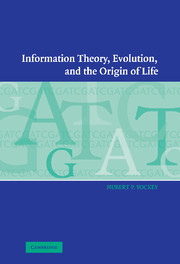Book contents
- Frontmatter
- Contents
- Preface
- 1 The genetic information system
- 2 James Watson, Francis Crick, George Gamow, and the genetic code
- 3 The Central Dogma of molecular biology
- 4 The measure of the information content in the genetic message
- 5 Communication of information from the genome to the proteome
- 6 The information content or complexity of protein families
- 7 Evolution of the genetic code and its modern characteristics
- 8 Haeckel's Urschleim and the role of the Central Dogma in the origin of life
- 9 Philosophical approaches to the origin of life
- 10 The error catastrophe and the hypercycles of Eigen and Schuster
- 11 Randomness, complexity, the unknowable, and the impossible
- 12 Does evolution need an intelligent designer?
- 13 Epilogue
- Mathematical appendix
- Glossary
- References
- Index
2 - James Watson, Francis Crick, George Gamow, and the genetic code
Published online by Cambridge University Press: 15 August 2009
- Frontmatter
- Contents
- Preface
- 1 The genetic information system
- 2 James Watson, Francis Crick, George Gamow, and the genetic code
- 3 The Central Dogma of molecular biology
- 4 The measure of the information content in the genetic message
- 5 Communication of information from the genome to the proteome
- 6 The information content or complexity of protein families
- 7 Evolution of the genetic code and its modern characteristics
- 8 Haeckel's Urschleim and the role of the Central Dogma in the origin of life
- 9 Philosophical approaches to the origin of life
- 10 The error catastrophe and the hypercycles of Eigen and Schuster
- 11 Randomness, complexity, the unknowable, and the impossible
- 12 Does evolution need an intelligent designer?
- 13 Epilogue
- Mathematical appendix
- Glossary
- References
- Index
Summary
The evidence presented supports the belief that a nucleic acid of the desoxyribose type is the fundamental unit of the transforming principle of Pneumococcus Type III.
Avery et al. Journal Experimental Medicine79, 137–159 (1943)The phosphate-sugar backbone of our model is completely regular, but any sequence of the pairs of bases may fit into the structure. It follows that in a long molecule many different permutations are possible, and it therefore seems likely that the precise sequence of the bases is the code which carries the genetical information. If the actual order of the bases on one of the pair of chains were given, one could write down the exact order on the other one. Thus one chain is, as it were, the complement of the other, and it is this feature which suggests how the deooxyribosenucleic acid might duplicate itself.
Watson and Crick (1953b, pp. 964–5)In a communication in Nature of May 30, p 964, J. D. Watson and F. H. C. Crick showed that the molecule of deoxyribosenucleic acid, which can be considered as a chromosome fibre, consists of two parallel chains formed by only four different kinds of nucleotides. These are either (1) adenine, or (2) thymine, or (3) guanine, or (4) cytosine with sugar and phosphate molecules attached to them. Thus the hereditary properties of any given organism could be characterized by a long number written in a four-digital system. On the other hand, the enzymes (proteins), the composition of which must be completely determined by the deoxyribosenucleic acid molecule, are long peptide chains formed by about twenty different kinds of amino-acids, and can be considered as long ‘words’ based on a 20-letter alphabet. […]
- Type
- Chapter
- Information
- Publisher: Cambridge University PressPrint publication year: 2005



